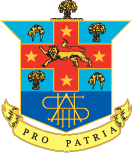Top Qs
Timeline
Chat
Perspective
Hurlstone Agricultural High School
School in Australia From Wikipedia, the free encyclopedia
Remove ads
Hurlstone Agricultural High School (HAHS, colloquially as Hurlstone Ag) is a government-funded co-educational academically selective and specialist secondary day and boarding school, located in Glenfield, a south-western suburb of Sydney, in the Macarthur region of New South Wales, Australia. HAHS is the oldest government boarding school in New South Wales.[1]
Farrer Memorial Agricultural High School, Yanco Agricultural High School and Hurlstone Agricultural High School are the state's only public selective and agricultural schools that also include a co-educational boarding school. The 112-hectare (277-acre) Hurlstone Agricultural campus includes classroom blocks, an operational farm, sporting facilities and student accommodation.[2]
Remove ads
History
Summarize
Perspective

Hurlstone was established as a boys-only school in 1907 in Hurlstone Park, approximately ten kilometres southwest of Sydney, at the present site of Trinity Grammar School. The original owner of the land was a teacher, John Kinloch, one of the first graduates of the University of Sydney. He named the land Hurlstone Estate, after his mother's maiden name and set up his own school on it in 1878 which he called the Hurlstone School and College.[3]
Hurlstone Agricultural Continuation School
In those days, most students completed their schooling after primary school and students at Hurlstone Agricultural Continuation School (as it was known at the time) studied there for only two years.
In 1926, the school moved to its present site in Glenfield, approximately 42 km southwest of Sydney (between Liverpool and Campbelltown) and adjacent to Glenfield railway station. By then its student numbers had grown from 30 in 1907, to 148.[3] The school supported government policy to promote productivity in the agricultural sector through the training of boys in all aspects of agricultural sciences and farm management.
Macarthur Agricultural High School; co-educational enrolment
For a brief period in the early 1940s, it was known as Macarthur Agricultural High School in honour of wool-grower John Macarthur, but it soon reverted to its previous name.
Hurlstone was a boys' school until 1979, when the decision was made to become co-educational.[3]
Sale of school farmland
In 2008, the New South Wales Government declared 140 hectares of Hurlstone's farmland "surplus" and proposed the sale of the land, leaving the school with just 20 hectares.[4] The announcement was met with immediate public protest[5] and the formation of a local community group Save Hurlstone Educational and Agricultural Property (SHEAP)[6] eventuating in a government inquiry into the proposed sale and proceeds of the sale.[7] There was further pressure against the plans when the National Trust heritage listed the school in late 2009.[8] The government inquiry resulted in a recommendation of the sale of a small parcel of school land with the proceeds intended to help upgrade school facilities.[7]
On 18 November 2015, there was another proposal to sell the land the school and its farm operated on.[9]
Remove ads
Principals

The following individuals have served as principal of the Hurlstone Agricultural High School:
Remove ads
Population

Enrolment at the school is dependent on selective examinations of Year 6 students from across the state. New students coming in later grades have to sit a similar exam.[10]
Campus
Summarize
Perspective

Hurlstone features a fully functional farm and a commercial dairy. Animals on the farm include: beef and dairy cattle, sheep, horses, pigs, and chickens.[11] Clarke House is a heritage listed building which houses Hurlstone's memorabilia museum.[12]
The school also hosts a memorial forest and cairn on Roy Watts Road, past the boarding school. Established in 1950, it is believed to be Australia's first living war memorial, with a gum tree dedicated to each of the 600 students from the school who served in WWI and II.[13] Currently, ANZAC and Remembrance Day ceremonies are held at the memorial forest.
As part of the 2008 mini-budget, the New South Wales Government declared 140 hectares of the school to be surplus to educational needs and the land will be sold in 2011.[4] However, due to a strong public protest against this action,[5] an inquiry was led into process of selling approximately seven-eighths of the school.[7] As a result, Mal Peters, the Inquiry Chair, recommended the school's agricultural sector to be upgraded in order to reflect current industry practice and standards due to it being an economic, wise and important public investment for the people of NSW as it supplies young scientists with the knowledge for the ever declining, but demanding agricultural sector of the world.[14]
In 2020 a new school called Hurlstone Agricultural High School was to open at Western Sydney University, Hawkesbury.[15] The existing school in Glenfield would be renamed Roy Watts High School (after Hurlstone alumnus Roy Watts) and would remain fully selective but would no longer be an agricultural school.[16] However, this decision was cancelled in December 2019. The farm land would have been converted to a new public school as well as housing and a shopping centre.[17]
Remove ads
Notable alumni
- Phil Burton – Australian musician, member of the Australian pop vocal band Human Nature
- Alan O. Trounson (1958–1962) – biologist, stem cell researcher and IVF pioneer[18]
Military
- Mark Binskin – Chief of the Defence Force (CDF) Australia.[19]
- John Hurst Edmondson VC – soldier in World War II; the Hurlstone school hall is named in his honour[20]
- Sir William Keys AC, MC – National Secretary of RSL[21]
Politics, public service and the law
- John Kerin – Australian Labor Party politician, former Federal Treasurer (1991), Minister for Transport and Communications (1991), Minister for Primary Industries and Energy (1983-1991) and Member for Werriwa
- Mark Latham – politician, former Leader of the Australian Labor Party[22]
- Dick Klugman – Member for the federal seat of Prospect 1969–1990, Co-founder of NSW Council for Civil Liberties;[23]
Sport
- David Lyons – rugby union player, Wallabies[24]
- Cec Ramalli – Wallaby[25]
- Charles Melton – winemaker[26]
Remove ads
See also
References
External links
Wikiwand - on
Seamless Wikipedia browsing. On steroids.
Remove ads


